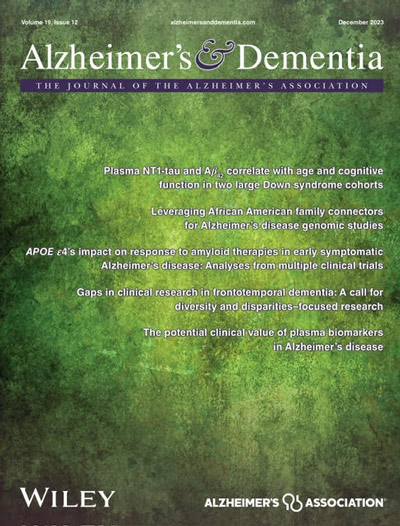Blood-based biomarkers for Alzheimer's disease in Down syndrome: A systematic review and meta-analysis
Abstract
Individuals with Down syndrome (DS) are at high risk of Alzheimer's disease (AD), displaying AD pathology similar to the general population. This study evaluated AD-related blood biomarkers in DS within the AT(N) framework through a systematic review and meta-analysis of studies published between 2017 and October 2024. The meta-analysis focused on plasma amyloid beta (Aβ)42, Aβ40, total tau (t-tau), phosphorylated tau (p-tau)181, neurofilament light chain (NfL), and glial fibrillary acidic protein (GFAP) levels, comparing 2109 DS individuals and 1006 euploid controls. Plasma Aβ42, Aβ40, NfL, and GFAP levels were significantly elevated in DS compared to euploid controls, while the Aβ42/40 ratio was reduced. In DS-AD individuals, Aβ42 and t-tau levels were elevated, with p-tau181, NfL, and GFAP consistently high across clinical subgroups. Notably, Aβ40 and the Aβ42/40 ratio changed significantly in preclinical AD, while t-tau increased in clinical AD. Incorporating inflammation (I) markers highlights neuroinflammation's role in DS-AD progression, supporting the blood-based AT(N)I framework for early AD detection and monitoring in DS.
Highlights
- We reviewed 58 studies on Down syndrome (DS) blood biomarkers and a meta-analysis of 18 using single molecule array.
- Plasma amyloid beta (Aβ)42, Aβ40, neurofilament light chain (NfL), and glial fibrillary acidic protein (GFAP) levels were elevated in DS compared to controls.
- DS-Alzheimer's disease (AD) individuals showed higher Aβ42, total tau (t-tau), phosphorylated tau (p-tau)181, NfL, and GFAP levels.
- Plasma p-tau181, NfL, and GFAP were elevated across all clinical subgroups.
- Aβ40 and Aβ42/40 ratio changed in preclinical AD; t-tau rose in clinical AD.


 求助内容:
求助内容: 应助结果提醒方式:
应助结果提醒方式:


